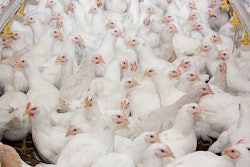Summertime brings a new set of challenges to poultry producers, including managing heat stress and ensuring broilers do not go off feed. However, summer is also an ideal time to get ahead of coccidiosis. It provides an opportunity to dry the litter out and reduce cocci cycling and challenges in the house. However, it’s important to select an anticoccidial program that won’t cause feed refusal issues in broilers.
Options to Control Coccidiosis in Chickens
There is a broad spectrum of options to control coccidiosis in chickens during the summer including vaccines, chemicals and ionophores. Ionophores work well in a summer program because of their wide dose range providing the producer with flexibility to adjust the dose rate to reflect the coccidiosis challenge. A lower dose of ionophores can be used resulting in less feed refusal compared to a chemical that must be used at the full dose rate.
“A lot of producers like to use a coccidiosis vaccine in the summertime. In this program, I recommend feeding an ionophore in the grower and finisher ration,” says Francene Van Sambeek, poultry technical consultant for Elanco Animal Health. “If you're in a situation where you don't want to use a coccidial vaccine, an ionophore-only program provides solid coccidiosis protection while at the same time limiting feed refusal that we worry about so much in the summertime.”
Van Sambeek offers the following suggestions.
- Option 1. Feed an ionophore in the starter, grower and finisher rations. With a flexible dose range, a producer can dial-in the amount of coccidial protection needed. These programs are often used for up to four months.
- Option 2. Use a dual-action anticoccidial in the starter ration followed by an ionophore-only product in the grower and finisher ration. This program helps control more of the earlier cycling coccidia and can be used up to six months with solid coccidiosis control which improves performance.
Fewer Program Rotations Benefit Gut Integrity
Since ionophores offer a unique mode of action and provide a wider dose range, producers have more flexibility when developing an anticoccidial program. Plus, fewer anticoccidial rotations also help maintain gut integrity and intestinal integrity index scores.
“Anytime we rotate in-feed additives, it disrupts the birds gut flora or gut balance,” says Van Sambeek. “It takes time for the gut flora to rebalance and adjust to the new in-feed additives, and bird performance will typically decline during this transition.”
Van Sambeek recommends rotating your anticoccidial program no more than three times in a year. This helps with overall planning, management, gut integrity, bird performance and coccidiosis control.
Heat Stress Mitigation Strategies Help with Feed Intake
Another way to mitigate the impact of heat and humidity on feed intake is proper management of the chicken house. Because chickens cannot sweat, there are only two ways that they can release body heat. One is by panting and the other is having air flowing over them where they can fluff up their feathers and use evaporative cooling to release body heat.
Van Sambeek offers the following tips to help producers manage the negative impact of heat and humidity on bird welfare and feed intake this summer:
- Spend time in the house. Producers should be spending extra time in the broiler house during hot and humid conditions to see what bird behavior is telling you. When birds start to pant, that leads to a metabolic change in the bird’s biochemistry, causing the birds to have a decreased desire to eat. If they are not eating, they are not going to gain weight.
- Provide access to adequate water. It’s important to ensure the water lines supplying the poultry house have the capacity to meet the birds’ water consumption needs in extreme heat conditions. Oftentimes, the drinkers and cool cell pads share a common water line, and this can divert water away from the birds when they need it the most.
- Keep air moving. Constant airflow in the chicken house during summertime is vital. Producers need to ensure the house fans are cycling on and off at the right times, fan belts are tight so the fans are running at optimal speed and efficiency, and fans are running after sunset to take advantage of the nighttime cooling off period.
- Clean and manage cool cell pads. This is a great technology to help reduce heat and humidity in the chicken house when managed properly. First, make sure the cool cell pads are clean and free of mold. Then wait until the house temperature reaches 85 degrees Fahrenheit before turning on the water to the cool cell pads, otherwise you're increasing the humidity in the house rather than decreasing it.
To learn more about using ionophores to help control coccidiosis and limit anorexia in heat stress conditions download Elanco’s new technical report.















